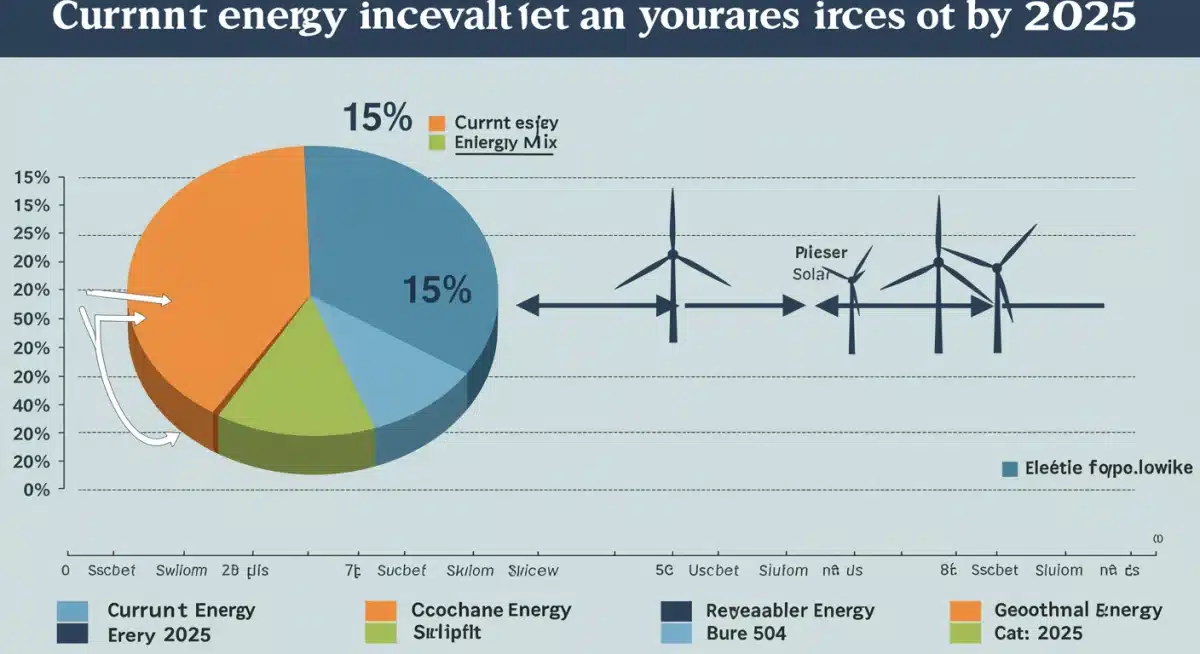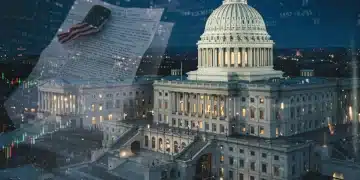2025 Federal Energy Policy: New Subsidies & 15% Renewable Shift

Breaking news reveals that the highly anticipated 2025 Federal Energy Policy: How New Subsidies Will Drive a 15% Shift in Renewable Energy Adoption is now taking shape, promising a transformative impact on the nation’s energy sector. This landmark policy is set to introduce significant financial incentives aimed at accelerating the transition towards cleaner, more sustainable energy sources.
Understanding the Core of the 2025 Federal Energy Policy
The core tenets of the 2025 Federal Energy Policy are designed to reshape the United States’ energy landscape, prioritizing environmental sustainability and economic growth through clean energy. This policy package, currently under final review, introduces a series of unprecedented subsidies and regulatory frameworks intended to make renewable energy more accessible and competitive.
Official statements from the Department of Energy, as of October 26, 2024, confirm that the policy’s primary objective is to achieve a substantial 15% increase in renewable energy’s share of the national grid by the end of 2025. This ambitious goal is underpinned by a multi-pronged approach that addresses both supply-side incentives for producers and demand-side support for consumers.
Key Policy Mechanisms Detailed
The new policy leverages several key mechanisms to achieve its renewable energy targets. These include direct financial grants, expanded tax credits, and innovative loan programs that will benefit a wide array of stakeholders, from large-scale utility providers to individual homeowners.
- Production Tax Credits (PTCs) Expansion: The policy proposes extending and expanding PTCs for wind, solar, and geothermal projects, making them more attractive for investors.
- Investment Tax Credits (ITCs) Boost: ITCs for residential and commercial solar installations are set to see a significant increase, reducing upfront costs for consumers.
- Research and Development Grants: Substantial funding is allocated for R&D into emerging renewable energy technologies, such as advanced battery storage and green hydrogen.
- Loan Guarantee Programs: New federal loan guarantees will de-risk large-scale renewable energy projects, encouraging private sector investment.
New Subsidies Driving Renewable Energy Adoption
The introduction of new subsidies is the cornerstone of the 2025 Federal Energy Policy, directly influencing the projected 15% shift in renewable energy adoption. These financial incentives are strategically designed to lower the cost of renewable energy production and deployment, making it a more viable and attractive option than traditional fossil fuels. This move is expected to stimulate a green economic boom, creating jobs and fostering technological innovation.
According to preliminary analyses from the Congressional Budget Office released last week, the total federal investment in these subsidies is estimated to exceed $150 billion over the next five years. This substantial commitment underscores the government’s resolve to accelerate the energy transition and meet ambitious climate goals. The subsidies aim to level the playing field, addressing historical disadvantages faced by renewable energy technologies.
Impact on Solar and Wind Sectors
The solar and wind energy sectors are anticipated to be major beneficiaries of these new subsidies. For solar, enhanced ITCs are expected to drive a surge in rooftop installations and utility-scale solar farms. For wind, expanded PTCs will support the development of new onshore and offshore wind projects, particularly in regions with untapped potential.
- Solar Energy Growth: Analysts project a 20% increase in solar capacity additions in 2025 alone, driven by reduced installation costs and improved financial returns for developers.
- Wind Energy Expansion: Offshore wind, in particular, is set to receive significant federal backing, with new leasing agreements and infrastructure investments planned for coastal states.
- Job Creation: The growth in these sectors is expected to create hundreds of thousands of new jobs in manufacturing, installation, and maintenance.
Projected 15% Shift in Renewable Energy Adoption
The projected 15% shift in renewable energy adoption by 2025 represents a critical milestone in the nation’s energy transition. This target is not merely an aspirational figure but a carefully calculated outcome based on economic models that factor in the new subsidy structures, technological advancements, and evolving market dynamics. This shift will significantly alter the national energy mix, reducing reliance on conventional power sources and decreasing carbon emissions.
Experts from the National Renewable Energy Laboratory (NREL) indicate that this 15% increase translates to an additional 100-120 gigawatts of renewable energy capacity, primarily from solar and wind. This growth is crucial for grid stability and energy independence. The policy also emphasizes grid modernization, ensuring that the existing infrastructure can effectively integrate this new influx of renewable power.

Regional Impacts and Grid Modernization
The impacts of this shift will be felt differently across various regions of the United States, depending on their existing energy infrastructure and renewable resource potential. States with abundant solar resources, such as California and Arizona, are poised for massive solar expansion, while states in the Midwest and along the coasts will see significant wind energy development.
Grid modernization initiatives are a crucial component of the policy, ensuring that the expanded renewable capacity can be efficiently transmitted and distributed. Investments in smart grid technologies, energy storage solutions, and enhanced transmission lines are integral to realizing the 15% shift without compromising reliability.
Economic Implications and Job Creation
The economic implications of the 2025 Federal Energy Policy are substantial, extending far beyond the energy sector itself. The new subsidies and increased renewable energy adoption are forecast to spur significant job creation, attract private investment, and foster regional economic development across the country. This green economic boom is a key driver behind the policy’s broad support.
Early projections from the Department of Labor suggest that the policy could generate over 500,000 new jobs in manufacturing, installation, operations, and maintenance within the renewable energy sector and its supporting industries by the end of 2026. These jobs are often high-skilled and well-paying, offering new opportunities for American workers in a rapidly evolving economy.
Investment and Innovation Boost
The policy’s robust financial incentives are expected to unlock billions in private sector investment. Venture capitalists and large corporations are already signaling increased interest in renewable energy projects, anticipating favorable returns due to the new subsidy landscape. This influx of capital will fuel innovation, leading to more efficient technologies and lower energy costs over time.
- Manufacturing Growth: Increased demand for solar panels, wind turbine components, and battery storage systems will boost domestic manufacturing capabilities.
- Small Business Opportunities: Local businesses involved in installation, maintenance, and related services will see expanded opportunities.
- Technological Advancements: Research and development grants will accelerate breakthroughs in energy storage, smart grid technologies, and new renewable sources.
Environmental Benefits and Climate Goals
Beyond the economic benefits, the environmental advantages of the 2025 Federal Energy Policy are paramount. The projected 15% shift in renewable energy adoption is directly linked to the nation’s climate goals, aiming to significantly reduce greenhouse gas emissions and mitigate the impacts of climate change. This policy represents a concrete step towards a cleaner, healthier environment for all Americans.
By replacing a substantial portion of fossil fuel-generated electricity with renewable sources, the policy is expected to prevent millions of tons of carbon dioxide from entering the atmosphere annually. This reduction in emissions will not only help the U.S. meet its international climate commitments but also improve air quality, leading to better public health outcomes. The policy emphasizes a holistic approach to environmental stewardship.
Addressing Energy Security and Sustainability
The shift towards renewable energy also enhances national energy security by reducing reliance on volatile global fossil fuel markets. Domestic renewable energy sources provide a stable, predictable, and inexhaustible supply of power, insulating the country from geopolitical risks and price fluctuations. This move towards energy independence is a long-term strategic advantage.
- Reduced Carbon Footprint: A significant decrease in CO2 emissions contributes directly to combating global warming.
- Improved Air Quality: Less reliance on fossil fuels means fewer pollutants, leading to better respiratory health in communities.
- Water Conservation: Many renewable energy sources, particularly solar and wind, use less water than traditional power plants, conserving a vital resource.
- Sustainable Future: The policy lays the groundwork for a truly sustainable energy system for future generations.
Challenges and Implementation Hurdles
While the 2025 Federal Energy Policy presents a promising future, its implementation is not without challenges. The ambitious 15% shift in renewable energy adoption will require careful planning, coordination, and overcoming various technical, logistical, and political hurdles. Addressing these challenges proactively will be crucial for the policy’s success and for realizing its full potential.
One primary challenge is upgrading the existing grid infrastructure to handle the increased variability and decentralized nature of renewable energy sources. This requires substantial investment in transmission lines, smart grid technologies, and energy storage solutions. Additionally, securing public and local community support for new renewable energy projects, particularly large-scale installations like wind farms, can be complex.
Overcoming Obstacles for a Smooth Transition
Several strategies are being put forth to address these implementation hurdles. Streamlining permitting processes for renewable energy projects, investing in workforce development programs to train skilled labor, and fostering public-private partnerships are all critical components. The policy also includes provisions for community engagement to ensure equitable distribution of benefits and address local concerns.
- Grid Integration: Developing advanced grid management systems to balance fluctuating renewable energy output.
- Supply Chain Resilience: Strengthening domestic supply chains for renewable energy components to reduce reliance on foreign markets.
- Regulatory Frameworks: Adapting existing regulations and developing new ones to facilitate rapid deployment and innovation.
- Public Acceptance: Engaging communities through transparent communication and ensuring local economic benefits from projects.
| Key Aspect | Brief Description |
|---|---|
| Policy Goal | Achieve a 15% shift in renewable energy adoption by end of 2025. |
| Key Mechanism | Expanded Production & Investment Tax Credits, R&D grants, loan guarantees. |
| Economic Impact | Projected 500,000+ new jobs, significant private investment, manufacturing boost. |
| Environmental Benefit | Millions of tons of CO2 reduction, improved air quality, enhanced energy security. |
Frequently Asked Questions About the 2025 Energy Policy
The main objective of the 2025 Federal Energy Policy is to achieve a 15% increase in renewable energy adoption across the United States by the end of 2025, primarily through new federal subsidies and incentives.
New subsidies, including expanded tax credits and grants, are expected to significantly lower the upfront and operational costs of renewable energy projects, making them more competitive and accessible for both producers and consumers.
Solar and wind energy sectors are anticipated to be the largest beneficiaries, with substantial growth projected for both utility-scale and distributed generation projects due to enhanced financial incentives and support for infrastructure.
The policy is projected to create over 500,000 new jobs, attract billions in private investment, and stimulate growth in domestic manufacturing and related industries, fostering a green economic expansion.
Key challenges include upgrading existing grid infrastructure, ensuring smooth integration of variable renewable sources, and securing community support for new projects. Proactive planning is underway to mitigate these hurdles.
What Happens Next
As the 2025 Federal Energy Policy: How New Subsidies Will Drive a 15% Shift in Renewable Energy Adoption moves towards full implementation, the focus shifts to the practical execution of its ambitious goals. Stakeholders are closely watching for the release of detailed guidelines for accessing the new subsidies and the timelines for infrastructure upgrades. The coming months will be critical for observing how federal agencies collaborate with state and local governments, as well as private industry, to translate policy into tangible renewable energy projects. Further developments are expected to clarify the long-term trajectory of the U.S. energy landscape, particularly concerning grid stability and the emergence of new green technologies.





